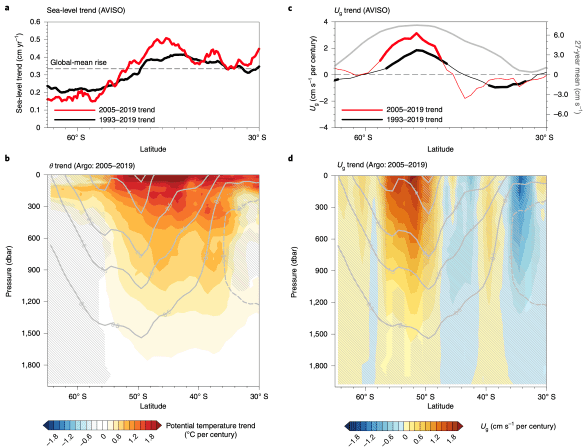In an article published in the Nov. 29 issue of Nature Climate Change, researchers from Woods Hole Oceanographic Institution and Scripps Institution of Oceanography found the robust acceleration of Southern Ocean zonal flow based on the independent satellite altimeter and hydrographic data since 1993. This statistically significant acceleration of zonal flow is reproduced in a hierarchy of climate models, including an ocean-eddy-resolving model. Guided by the model ensemble, the observed, significant acceleration has just emerged from the background variability only during the recent decade.
Previous studies paid much attention to the wind change on the ocean circulation in a changing climate. The Southern Ocean, as the predominant anthropogenic heat absorber, has shown a differential warming pattern between the upwelling regime and the subtropical region to the north of the Antarctic Circumpolar Current. The article shows that this uneven buoyancy distribution is linked with the acceleration of zonal velocity in the upper layer due to the increase of meridional density gradient. Change in westerly winds, which was widely discussed in previous studies as the main driver of Southern Ocean climate change, is found to play a secondary role in the acceleration. It highlights the need to consider the subsurface temperature or density change as drivers of the Southern Ocean circulation or even global ocean circulation change.
It’s important to note that the Southern Ocean zonal flow acceleration is expected to continue and even increase in the future given the continuing role of the Southern Ocean anthropogenic heat uptake and equatorward heat transport. It again draws our attention to have a better understanding of the responses in the ocean interior by using Argo floats.
This study is supported by the Southern Ocean Carbon and Climate Observations and Modeling (SOCCOM) project. Here is a news release from Scripps Institution of Oceanography, https://scripps.ucsd.edu/news/climate-change-making-one-worlds-strongest-currents-flow-faster?auHash=3iEElCNzWlofLr3Q-uE_JrsPBd3Izo7Q7Y876BT25cA.

Zonal mean sea-level, subsurface temperature, and geostrophic velocity trends from observations. a, Zonal mean sea-level trend from AVISO for 1993-2019 (black) and 2005-2019 (red). The global mean sea-level trend (0.33 cm per year from 1993 to 2019) is the dashed gray line. b, Potential temperature trend (2005-2019) from Argo. c, Zonal geostrophic velocity (Ug) trend from AVISO. Climatological (1993-2019) surface Ug (cm/s) from AVISO is the gray curve. d, The same from Argo relative to 2000 dbar. Gray contours in b and d are the climatological Ug based on Argo (cm/s), with solid contours representing eastward flow and dashed contours representing westward flow. Hatched regions b and d indicate that the trends are not significant at the 95% confidence level from the two-tailed t test. Thick curves in a and c show latitudes exceeding 95% statistical significance. Figure credit: Shi et al. Nature Climate Change, 2021.
